
The Spark-o-phone
The Spark-O-Phone featured in the Photophonic Experiment Tour around the UK in Oct/Nov 2006 Press feature
Sounds improvised by electrons...
Whilst playing with a 25kV flyback supply and some capacitors to make some nice fat sparks, I wondered what the effect would be if they were combined with a resonant tube. A quick experiment with some plastic tubing looked very promising, and so was born the Spark-O-Phone...!
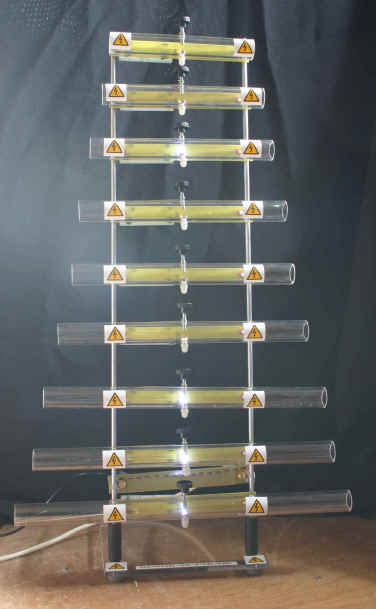
The caps are charged via 100 megohm high-voltage resistors, producing a
regular spark discharge at intervals in the range 0.2 to 5 seconds, depending on the
applied voltage and gap width.
An interesting effect that occurs when you connect several of these circuits to the same
supply, is that some interaction takes place, as the varying current drawn by the
capacitor charge/discharge cycle influences the charge rate of the other capacitors. When
you have only 2 or 3 tubes running, they will sometimes drift into a synchronised pattern.
This effect can be augmented by various cross-coupling arrangements between stages, and
will be investigated further in future.
As the number of tubes increases, the interaction effect tends to avarage out, leading to a more regular beat for each of the tubes, but the larger number of different notes tends to disguise the regular beat of each tube and produce a more random-sounding 'tune' (jazz mode - nice). Small adjustments to the gaps have a significant effect on the sound patterns. Adjusting the supply voltage slowly controls the avarage tempo of the generated sounds, and other interesting effects can be produced by setting some gaps wider so they only start firing at the higher input voltage settings..
Watch & hear the Spark-O-Phone in action : MPEG version (2.6MB) AVI version (4.6MB) Sound only : MP3 (375K) (Note that the audio compression artefacts on the MP3 version, tend to turn the very sharp clickiness of the sparks into a softer 'fuzzy' sort of noise, the sound on the AVI and Mpeg versions is more realistic).
Things get more interesting if you start modulating the power supply voltage over time. Simply switching it on and off at regular intervals imposes a rythmic beat to the sound, as sparks will only occur when power is on. Adjusting the on/off ratio controls how strictly the spark timing follows the beat - with a short on-time, the sparks happen pretty much together, usually several at a time. As the 'on' time gets longer, the spark timing spreads out.
Hear the result : pulsed.mp3 (1.4MB) In this sample, the only manual intervention was occasional adjustment of the pulse rate and on/of ratio.
Other interesting effects can be acheived by slowly ramping the voltage up and down, producing patterns which get gradually more and less 'frantic'.
Acrylic tube was used so the sparks were nicely visible, and a set of
tubes were cut to resonate at musical notes A (440hz) upwards. The number of tubes was
dicated by the number of capacitors I had - these were 2.2n 25KV parts left over from my Marx Three 1MV marxgen.
After a lot of thought about physical construction, I hit upon the idea of mounting the
resistor, cap and tube on a strip of PCB, and using fuse clips to attatch the tubes to
metal rods for the HV supply. This arrangement offers a lot of flexibility, allowing
individual 'notes' to be added or removed (this could be used to play tunes in particular
keys), and different physical arrangements to be used - e.g. the circular 'hanging
lantern' arrangement shown below. Another possibility would be to have multiple supply
busbars, with tubes connected between different combinations to investigate
different interaction effects.
 Detail of one tube assembly - resistor and cap mounted on PCB, with fuse
clips to attatch assembly to supply rails. Thumbwheel allows gap adjustment
Detail of one tube assembly - resistor and cap mounted on PCB, with fuse
clips to attatch assembly to supply rails. Thumbwheel allows gap adjustment
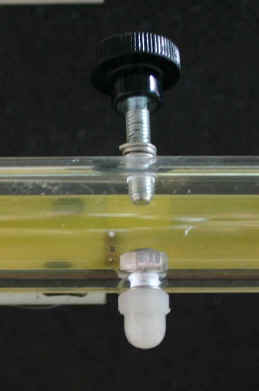 Gap detail. Ground side is adjusted with a thumbwheel running in an M5 tapped
hole in the tube. HV side of the gap is a M5 hex-head bolt, with nylon dome-nut to reduce
risk of getting zapped when adjusting the adjacent gap while live. Connections are by
tinned-copper wire wound round the threads. (Connection integrity is not critical - if
connection is poor it will just spark across!)
Gap detail. Ground side is adjusted with a thumbwheel running in an M5 tapped
hole in the tube. HV side of the gap is a M5 hex-head bolt, with nylon dome-nut to reduce
risk of getting zapped when adjusting the adjacent gap while live. Connections are by
tinned-copper wire wound round the threads. (Connection integrity is not critical - if
connection is poor it will just spark across!)
 Rear View
Rear View
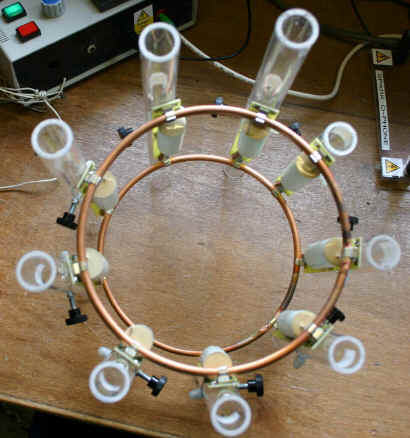
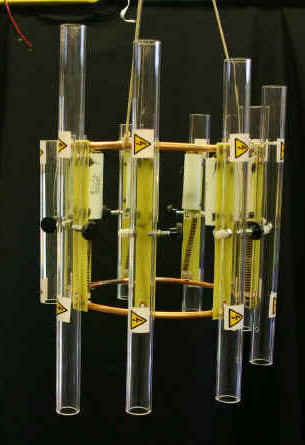 Alternative arrangement
using rings instead of vertical supply rods - this could easily be hung like a chandelier
to keep the high voltage out of reach of people.
Alternative arrangement
using rings instead of vertical supply rods - this could easily be hung like a chandelier
to keep the high voltage out of reach of people.
To help investigate the effects of controlling the supply voltage, I designed a purpose-built power supply, based on a PIC microcontroller, which allows software control of the drive to the flyback transformer, and hence output power. It currently provides modes for simple continuous adjustable output, square wave with adjustable duty cycle and min/max values, plus ramp & triangle modes. It is planned to add to this over time to provide things like external inputs (e.g. remote trigger, light, sound or PIR sensors to make it react to external influences), as well as sequencing and save/recall of preset settings. The controller board also provides a second PWM channel to allow dual supplies to be independently controlled.
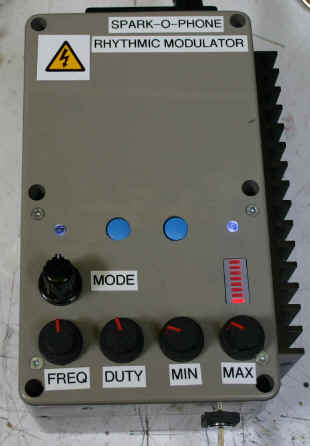
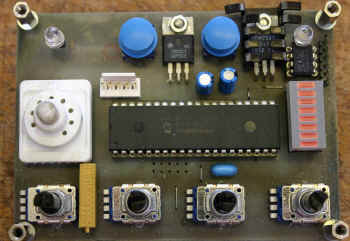
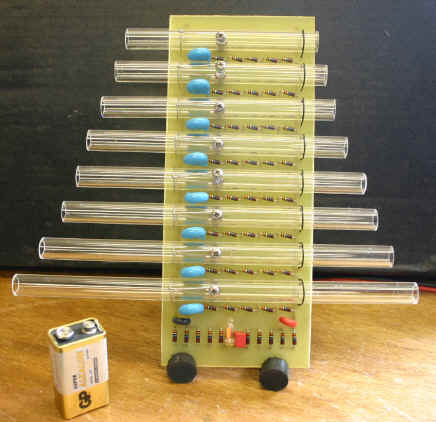 Miniature version - this used 2.2nf 7.5KV caps as these were easy to get hold
of.
Miniature version - this used 2.2nf 7.5KV caps as these were easy to get hold
of.
This smaller unit is a lot less impressive however, mostly due to the much lower volume as the gap firing voltage needed to be kept below 8KV to avoid killing the caps.
The smaller gaps are much more critical of adjustment, and seem to produce less
avriation and interaction effects than the larger one.
